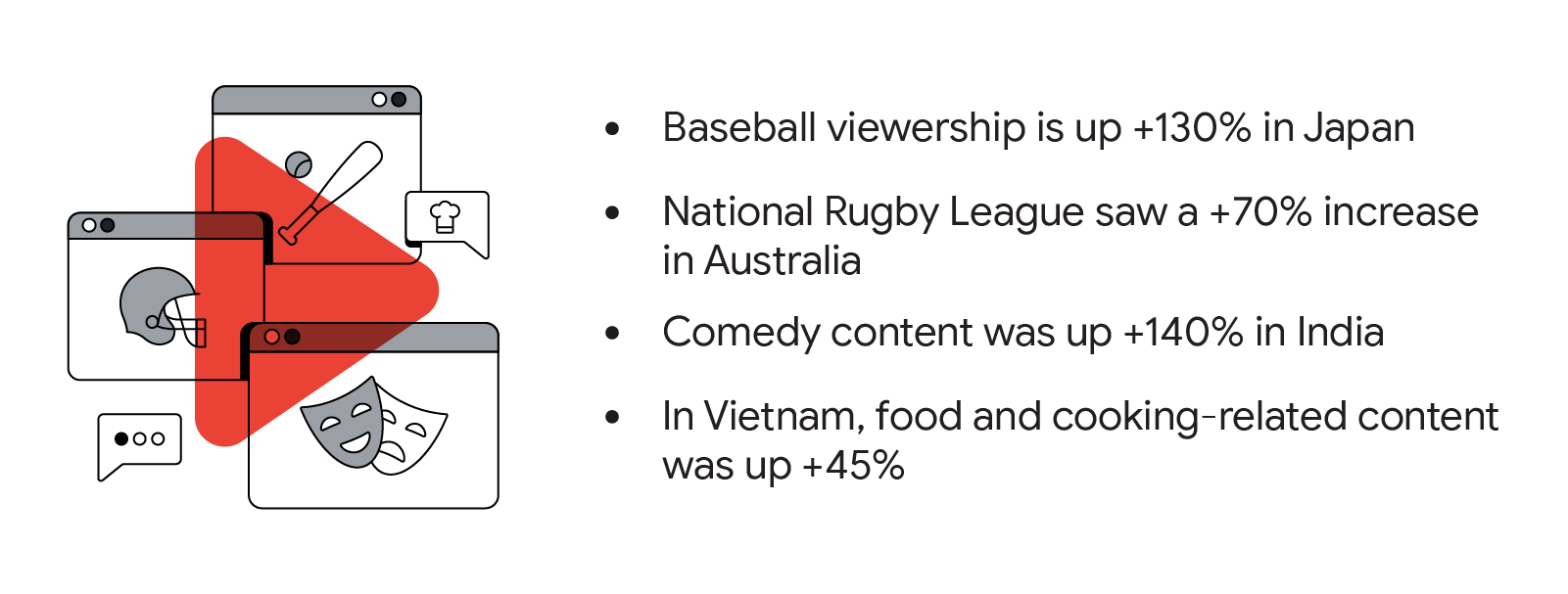
Brian Albert is Google’s managing director of agency and brand solutions in the U.S., leading teams that negotiate annual partnership deals with brands and agencies to help them plan and execute more effective video ads and content. Here, he shares his perspective on navigating the video streaming boom — with local insights provided by Gautam Ramdurai, Google’s marketing lead of YouTube Ads in APAC.
We spend a lot of time thinking about video: how advertisers can make the most of video platforms, what makes an effective video ad, and how behavioral shifts change the way people watch. From our perspective, we are entering a clear third stage of viewership.
Put another way, streaming was always the future — and the future is now.
During the decades-long first wave, we all watched the same kinds of videos in the same places. We watched primetime TV, sports, the news, and our favorite shows on broadcast. Everyone watched at home on a TV screen.
Then, over the past 10 years or so, online platforms like YouTube took off, marking the start of the second wave. Video went mobile. Mobile technology expanded where and when to watch — during commutes, on a lunch break, in bed — and gave us new use cases for video, like making DIY projects, learning new skills, and connecting with passionate communities.
Now we have entered the streaming era, which has, ironically, landed us back in the living room. People still watch a lot of mobile video, of course, but streaming video has taken off in APAC and globally, enabling us to use TV screens again in new ways.
Some of this growth has been driven by the fact that, these days, many more of us are at home, but streaming has also become mainstream. Put another way, streaming always was the future — and the future is now.
So, how should marketers respond to this third wave of viewership, given today’s fluid, dynamic market? As you reevaluate and adjust your advertising strategy for the rest of the year and beyond, keep streaming services top of mind. These platforms are drawing increasingly massive audiences and will help you reach the types of viewers that traditional TV misses.
Here’s an in-depth look at why people are shifting to streaming video and how you can make the most of it.
The explosion of streaming on the TV screen, by the numbers
Interestingly, we see CTV becoming the screen of choice for many viewers.
According to a 2020 report by Innovid, connected TV (CTV) takes up 40% of global video impression share by device.1 Across countries in APAC, almost two-thirds of the internet population are streaming or watching online TV on an average day.2
Meanwhile, a new generation of global viewers is now choosing to watch YouTube primarily on their CTV screens, with casting watch time for YouTube growing by more than 75% year-over-year (YoY).3 This makes CTV the fastest growing type of screen in 2020.4 Across APAC, this trend is picking up momentum, with 20 million people in Japan, 20 million in India, 25 million in Vietnam, and 8 million in Australia specifically watching YouTube on their CTVs.5
Interestingly, we see CTV becoming the screen of choice for many viewers. Some viewers in APAC (20% in Japan and Vietnam and 25% in Australia) watch YouTube almost exclusively on their CTV screen for 90% of the content they consume.6
Why streaming on TV screens is taking off
There’s less channel surfing and more personalization of our experiences.
The hallmark of broadcast TV has always been the hundreds of channels that cater to every interest — from personal to popular. To find out what sets streaming apart, we looked at TV streaming data across Japan, Australia, India, and Vietnam.
What we learned was that streaming offers people three distinct benefits: access, control, and relevance. People now have access to a huge volume of content — from documentaries to TV series — as well as the ability to find and discover fresh content and watch that content at a time that suits them.
In many ways, this is a story about technology. Streaming democratizes content production and our ability to find and consume it. There’s less channel surfing and more personalization of our experiences. Streaming gives us all the advantages of broadcast TV, but on our terms.
Globally, the versatility of video streaming has contributed to increased viewership on TV screens. For example, watch time of both ad-supported and purchased feature-length movies grew by 800% YoY, while watch time for live content is up 250%.7
In APAC specifically, watch time on TV screens is up across several content categories including sport, comedy, and food.

We’ve also seen that content freshness — and creators’ ability to make videos that reflect our evolving circumstances — adds to the appeal of streaming. Between mid-March and mid-April, 60% of viewers signed in to YouTube on TV screens to watch a video that had been published in the past seven days.
The rise in CTV viewers means that brands are now able to reach a much larger audience through the TV screen, including previously unplugged audiences like “cord cutters” and “cord nevers.”
Connected TV attracts a highly engaged audience
When people watch an ad with someone else, they experience double the emotional response they experience when watching on their own.
It’s not just quantity — CTV also presents an opportunity for brands to connect with a highly engaged audience. Research shows that viewers tend to spend more time in front of their CTV screens compared with streaming on mobile or desktop devices. They also have a larger appetite for long-form content, with viewers in countries like India watching videos on their CTVs that are up to 200% longer than those they watch on other devices.8
When a video plays on a CTV screen, there are more co-viewing opportunities for friends and family to gather in the same room to watch the content they love.
Interestingly for brands, when people watch an ad with someone else, they experience double the emotional response they experience when watching on their own.9
For video advertisers, this third wave of viewership can seem to be further fragmenting the audiences we are all trying so hard to reach. However, the streaming landscape is filled with opportunities to reach the audiences you care about, and brands should look to enhance — not disrupt — the CTV experience.
In a time when media spend needs to stretch farther than ever, CTV offers businesses measurable insight into the TV experience. This information helps ensure that your advertising strategy reaches the audiences you care about, in the places where they spend the most time, to help drive real results for your business.
Like what you read? You can also view this content as a visual story.








